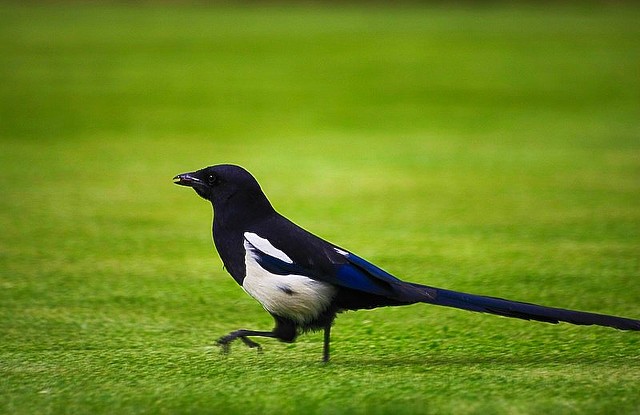Black-billed Magpie
A species of Magpies Scientific name : Pica hudsonia Genus : Magpies
Black-billed Magpie, A species of Magpies
Botanical name: Pica hudsonia
Genus: Magpies
Content
Description People often ask General Info
Description
A large, familiar bird of urban and suburban areas, this black-billed Magpie is often seen standing on road signs and fence posts. This opportunistic bird is known as the "raider" of other birds' nests. Thanks to its long tail, it is able to change the direction of flight suddenly. In some cultures, the black-billed Magpie is considered a bad omen.
Size
45 - 60 cm
Life Expectancy
2-20 years
Nest Placement
Tree
Clutch Size
1 - 9 eggs
Incubation Period
1 brood
Number of Broods
16 - 19 days
Nestling Period
24 - 30 days
Feeding Habits
Black-billed Magpie engages in diverse feeding strategies; these omnivores consume fruits, grains, insects like grasshoppers and beetles, small mammals, birds' eggs, and carrion including maggots. They are noted for scavenging predators' leftovers and delousing large mammals. They provision food for later use and predominantly feed their chicks with animal matter.
Habitat
Black-billed Magpie flourish in varied environments, primarily open regions with interspersed trees and shrubbery, including riparian woodlands adjacent to water bodies. Elevationally adaptive, they inhabit meadows, grasslands, sagebrush plains, and pine forests. These birds are also comfortable in human-altered landscapes such as farms, suburbs, and urban areas, often found near barnyards and grain elevators. Preferring territories that align with stream paths, black-billed Magpie seek proximity to protective cover against predators.
Nest Behavior
Both black-billed Magpie sexes participate in site selection and nest building, occasionally starting separate nests. They share construction duties with males collecting sticks and females shaping the internal mud cup.
Nest Characteristics
Black-billed Magpie typically nests in various locations including coniferous and deciduous trees, shrubs, utility poles, and deserted buildings, across open woodlands to suburban areas. Their dome-shaped nests are roughly 30 inches high and 20 inches wide, constructed from sticks with a mud cup interior lined with grass.
Dite type
Omnivorous
People often ask
General Info
Feeding Habits
Bird food type

Black Oil Sunflower Seeds

Hulled Sunflower Seeds

Suet

Cracked Corn

Peanuts

Peanut Hearts

Fruit

Millet

Milo
Bird Feeder Type

Platform

Ground
Behavior
Black-billed Magpie are known for their impressive aerial maneuvers, consisting of long, sweeping flights accentuated by their striking white wing patches and elongated tails. They display territorial behavior by perching conspicuously atop trees, akin to the vocal territorial announcements of other birds. On the ground, black-billed Magpie's movement is characterized by a distinctive confident strut. Socially, black-billed Magpie may congregate in flocks, participating in communal living and engage in cooperative behaviors, such as mobbing predators. Hierarchies within these groups are established through physical displays, with males asserting dominance via a specific stretch display, showing off their white eyelids, and wing and tail signals. Aggressive interactions are further communicated by flickering or quivering their white wing patches and tail feathers. Courtship involves similar tail displays and is initiated by the female through food solicitations, leading to the male's courtship feeding. Remarkably, black-billed Magpie are largely monogamous, with the male actively guarding its partner during breeding to prevent extra-pair copulation. One of the most extraordinary behaviors is the 'funeral' ritual, where upon discovering a deceased black-billed Magpie, an individual will vocalize loudly to summon others, resulting in a temporary gathering that exhibits collective mourning behaviors before dispersing in silence.
Distribution Area
Black-billed magpies range in the north from coastal southern Alaska, central British Columbia, and the southern halves of Alberta, Saskatchewan, and Manitoba, through the Rocky Mountains down south to all the Rocky Mountain states including New Mexico, Colorado, Utah, Wyoming, Idaho, and some bordering states as well. The range extends as far east as northern Minnesota and Iowa, with casual records in northern Wisconsin and upper Michigan, but is thought to be limited further east and south by high temperature and humidity. 
Species Status
The species is not threatened and in some areas it has benefited from forest fragmentation and agricultural developments. Like many corvids, however, it is susceptible to West Nile virus. In Canada, black-billed magpies do not appear on the list of birds protected by the Migratory Birds Convention Act. Provincial laws also apply, but in Alberta, magpies may be hunted and trapped without a license. 
Scientific Classification
Phylum
Chordates Class
Birds Order
Perching birds Family
Crows and jays Genus
Magpies Species
Black-billed Magpie 